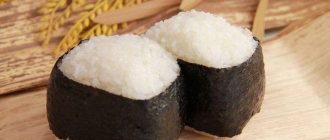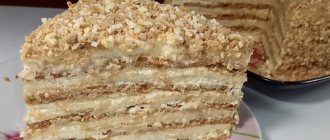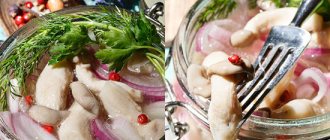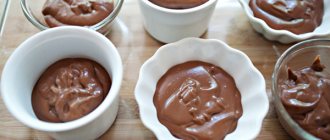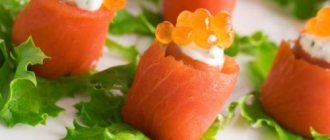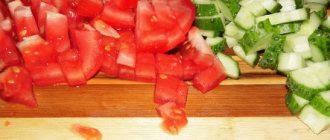Refined simplicity: classic Japanese dishes
- Japanese dishes are light and low in calories: they contain little fat and are perfectly digestible. Therefore, they are great for a balanced diet.
- Seaweed, which is actively used as ingredients, replenishes iodine deficiency - every second person in Russia experiences it.
- Fish and rice are sources of strength and energy, improve immunity, memory, and the functioning of the cardiovascular system.
- Japanese food is eaten leisurely to enjoy the palette of flavors. The food here has a special aesthetic that you will get great pleasure from experiencing!
Japanese pudding "Purin"
Japanese pudding has nothing in common with English pudding. It's called purine and is a vanilla custard flan topped with caramel syrup.
Japanese pudding “Purin” (photo: @cuisineenscene)
Recipe for Japanese pudding "Purin"
Ingredients
For caramel syrup:
- 1 cup sugar
- 50 ml water
For the custard:
- 2 glasses plus another 500 ml of milk separately
- 3 eggs
- 100 g sugar
- 1 teaspoon vanilla extract
Preparation:
Caramel syrup
Place sugar and water in a heavy-bottomed saucepan, but do not mix them. Place over medium heat and heat until mixture turns dark brown. Pour the syrup into 8 small ramekins.
Custard
- Heat the milk until almost boiling.
- Beat eggs and sugar and slowly add hot milk. Strain the mixture to make it an evenly smooth liquid, then add vanilla. Pour the mixture into the syrup molds.
- Place the molds on a large dish, which can be filled with hot water so that the cream is baked in a water bath.
- Bake the flans at 180°C for 40-45 minutes.
- Cool the finished flans at room temperature, then refrigerate for at least 3 hours, or preferably overnight.
- Before serving, carefully remove the flans from the molds into small serving dishes. You can decorate the top with whipped cream and a cherry.
PARTNER ADVERTISING
Japanese dishes with rice
Rice is the basis of most Japanese dishes: it is boiled, steamed, and even fried.
It is interesting that at first rice in Japan was the property of rich people, and entered the lives of common people later.
Rice for sushi and rolls must be chosen carefully: it has an oval shape, a light creamy tint and, when cooked, retains the grain structure without falling apart. Thanks to good adhesiveness, it is easy to form rolls or sushi even without experience.
Boiled rice gohan is the centerpiece of the table. If you add a raw egg and soy sauce to it, you get tamago kake gohan breakfast. And mochi rice cakes are made into sweets, added to soups and even wrapped in ice cream. Onigiri are rice balls with filling inside, wrapped in nori sheets. This simple Japanese dish is popular as an inexpensive and filling snack.
Dorayaki
A favorite delicacy of the Japanese, simple, but always popular with all ages. Dorayaki consists of two biscuits held together by a sweet azuki bean paste called anko. Of course, this classic version of sweetness can be varied as desired, and instead of bean paste, other ingredients can play the role of filling.
Dorayaki (photo: @peppefoodie)
Dorayaki recipe
- 4 eggs
- 140 g sugar
- 2 teaspoons liquid honey
- 160 g flour
- 2 tea
- spoons of water
- 1 sachet (10 g) baking powder
- 1 430g can red bean paste
Preparation:
- Whisk the eggs, honey and sugar in a large bowl until the mixture is fluffy.
- Add baking powder and flour. Mix everything and leave in the refrigerator for 15 minutes, then add a tablespoon of water.
- Heat a frying pan over low heat. Pour a small ladle of batter into the pan to form a pancake with a diameter of 9-10 centimeters. Fry the pancake until large bubbles appear on the surface, then flip and fry the other side.
- After all the pancakes are ready, form the dorayaki by placing the bean paste in the very center (not on the entire surface or along the edges!).
Dorayaki wrapped in cellophane can be stored for 2-3 days.
Pork Tonkatsu
How about meat, and pork at that? The highlight of these chops is the special Tonkatsu sauce.
To prepare you will need:
- Pork loin 2 cm thick;
- Salt pepper;
- Flour, breadcrumbs or panko crumbs;
- 2 eggs;
- Tonkatsu sauce.
The meat should be lightly beaten, seasoned, then rolled in flour and dipped in a beaten mixture of eggs and three tablespoons of water. Then sprinkle with breading and deep-fry until golden brown. Serve with boiled rice and Tonkatsu.
Ogura Cake
Japanese Ogura Cake is a basic version of a fluffy sponge cake, to which you can add different ingredients to give the dessert a new sound, bright color, or serve with different sweet sauces. By itself, it does not have a lot of calories, so by preparing such a dessert you don’t have to worry too much about immediately gaining extra pounds on your waist. This light sweet dessert can be called a combination of sponge cake and meringue in one dessert.
In the US, this cake is known as Angel Cake or Chiffon Cake .
Ogura cupcake (photo: @im_tryhansen)
Japanese Ogura cake recipe
Ingredients:
- 110 g flour
- 220 g sugar + 10 g for mold
- 10 egg whites
- 1 teaspoon vanilla essence
- 1 tablespoon lemon juice
- cream
- salt
- form for quiche or kuglof
Preparation:
- Preheat oven to 170°C.
- Sift the flour and sugar separately twice, and a third time sift the flour with 100 g of sugar and 1 pinch of salt.
- Whisk the egg whites with a pinch of salt. Once stiff, add the lemon juice, followed by the remaining sugar and vanilla, continuing to beat until stiff.
- Carefully fold the flour and sugar into the whites in small portions.
- Place the mixture in a mold previously greased with butter and sprinkled with sugar. Bake for about 45 minutes until the top of the cake is golden.
- Cut the finished cake into slices and serve with your favorite berry sauce or other syrup.
Soup with tuna and vegetables
Ingredients:
- Canned tuna Dongwon;
- Leeks and pearl onions;
- Turnip;
- Nori sheets;
- Young bamboo shoots and tofu cheese;
- Soy sauce, salt, pepper.
Boil diced onions and turnips, add pre-soaked nori sheets, bamboo, tofu and tuna pieces to the broth. Simmer for about 5 minutes. Season the soup with salt, pepper and a spoonful of soy sauce and serve hot.
Cook Japanese dishes at home: you'll get triple the pleasure. From the process, serving and unforgettable taste!
Japanese cheesecake
Japanese cheesecake of the most delicate yellow color has a uniform airy texture. It is very simple to prepare, because it is based on only three ingredients. A real find for a housewife who doesn’t have time to stand at the stove for a long time.
Japanese cheesecake (photo: @just_share_kuliner)
Japanese cheesecake recipe
Ingredients:
- 3 eggs
- 120 g white chocolate
- 120 g cream cheese (e.g. Philadelphia)
Preparation:
- Separate the whites from the yolks.
- Melt white chocolate in a water bath, add egg yolks and cream cheese.
- Beat the whites into a strong foam, then carefully combine with the previous mixture, obtaining a homogeneous dough.
- Pour the dough into the mold and bake in a water bath for 15 minutes at 170°C, and then 15 minutes at 160°C.
- Before removing the cheesecake from the oven, leave it in there for another 15 minutes. Then remove and cool.
Fast food
Japanese cuisine in the minds of Russian people is mainly associated with cold appetizers - they were the first to appear in our restaurants. Over time, we tasted the taste of sushi, learned that the “black thing” on the rolls is nori seaweed, the spicy pink petals are called ginger, and the scalding green clot on the plate is Japanese wasabi horseradish. By the way, there is nothing supernatural in preparing Japanese snacks. The main thing is to buy the necessary ingredients in a Japanese supermarket or order from an online store and learn how to make sushi and roll rolls - that’s what chefs call these processes.
Subtleties of Japanese etiquette. Table manners
Before starting the meal, itadakimasu is pronounced (“I accept with gratitude”) - an expression of gratitude to the owner of the house or the gods for the food, in use it corresponds to the Russian “bon appetit”.
Before eating, a damp, sometimes hot after sterilization, oshibori towel rolled into a tube is usually served. It is used to clean your hands before eating, but you can use it to wipe your face and hands both after and during meals, since some food can be eaten with your hands.
Traditionally, all dishes are served at the same time (in public catering, however, this tradition is usually violated), it is allowed (and considered decent) to try a little of all the dishes, and only then start eating “seriously”.
Traditionally, lunch begins with a small lump of rice. Then they eat a dish of raw fish, after that - soup, then the rest of the dishes. Rice and soups are eaten at any stage of lunch, alternating them with various snacks.
If a dish is served in a bowl covered with a lid, then after it is eaten, the bowl should be covered again.
At a home or formal dinner, some of the dishes (usually appetizers such as sushi, rolls, pieces of fish or meat, etc.) are laid out on common dishes, and each dinner participant is given a small plate on which he puts what he wants to try.
Food from a common dish is transferred with chopsticks to a personal plate. It is not customary to pick up a common dish.
Neighbors at the table pour drinks for each other. It is not customary to pour yourself a drink.
Toasts are not accepted in a traditional Japanese feast; drinking alcohol can be preceded by the word “kampai!” ("to the dregs!").
It is believed that the guest has not finished his meal while he still has rice in his bowl. Rice is eaten to the last grain. It is rude to leave the table without finishing your rice.
After finishing the meal, you should say gotiso:sama [desita], “it was very tasty”) - this is an expression of gratitude for the treat (analogous to the traditional “thank you” in European etiquette).
Brilliant teriyaki
Teriyaki is another traditional Japanese dish that can be easily prepared at home. Its name comes from two words: “teri” - “to shine” and “yaki” - “to fry”. Meat, fish or vegetables are first marinated in a special teriyaki sauce and then fried over coals or in a frying pan. The solution is made from game bones, so take one chicken, separate the meat from the skeleton and put the bones in the oven until dry. Now put 200 grams of zucchini, eggplant, carrots, celery, a little garlic and onions on the electric stove burner and keep them there until a black charred crust appears. After this, pour a liter of sweet rice wine myurin (can be replaced with sake), half a liter of soy sauce, 0.5 kg of sugar, charred chicken bones and vegetables into one pan, bring to a boil and cook for about an hour. Then strain the contents and cool it. The sauce should be black. If you don’t want to fuss with it for a long time, you can buy it ready-made. Soak meat in the sauce (in two hours it will soften even tough pieces), chicken or fish. Fry them a little in a frying pan. Then pour in the remaining sauce and simmer the food along with it. The dish turns out delicious and literally shiny, as if covered with varnish.
Rolls "California"
Ingredients:
- Rice (ready for sushi) – 100 g
- Crab meat – 50 g
- Cucumber – 20 g
- Avocado – 20 g
- Flying fish caviar – 20 g
- Nori - half sheet
- Mayonnaise – 20 g
- Chili sauce – 1-2 drops
Cooking method
| 1. Take a standard sheet of nori seaweed and carefully break it in half. Place one part on a bamboo mat and cover it evenly with a layer of boiled and sauce-soaked rice about 0.5 cm thick. Press the grains with your fingers, but not too hard. Leave about 1 cm of the nori sheet clean on one side. |
| 2. Sprinkle red flying fish roe over the rice |
| 3. Turn the sheet of nori over so that the rice and caviar are on the bottom. |
| 4. Mix mayonnaise with curry (you can do without hot sauce) and squeeze it onto a sheet of nori. |
| 5. Cut the boiled crab meat into small pieces (prepared ones are sold in Japanese supermarkets) and place it on mayonnaise. |
| 6. Cut the avocado and cucumber (it is better to take the fruit with pimples) into strips with a diameter of about 0.7 cm and place them on top. Using the makisa, begin to carefully roll the roll. She turned it - she pressed the bamboo mat, bent its edge and turned it again until the rolls took the correct shape. 7. Cut the “roll” in half, place the two parts parallel to each other and make 6-8 rolls. Secret : in order to cut the rolls, you need a very sharp knife. In this case, it must be periodically moistened with cold water. |
